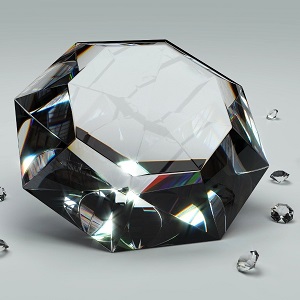Artificial hexagonal diamonds are more durable than their natural counterparts
Classic diamonds of the cubic system are very strong and durable. But enormous forces from meteorites or similar events can create hexagonal diamonds that are even stronger and more durable, as material scientists have now shown experimentally for the first time, equipped with gunpowder, gas, graphite, a laser, and sound waves.
–
Conventional diamond. Credit: Pixabay / CC0 Public Domain.
–
Diamond, a mineral crystallizing in a cubic system, is one of the hardest and most durable materials we know on Earth. But now it has competition, although we know this from experiments with artificially created material. The American team confirmed that diamonds with a hexagonal structure are even more durable than conventional diamonds.
Hexagonal diamonds are actually also natural. They occur in some places of impact of cosmic bodies. Materials scientists also produce them in laboratories. So far, however, they have been too small or have existed too short to be analyzed in detail. Now the situation has changed, thanks to the team of the Institute for Shock Physics of Washington State University, led by Travis Volz. They were able to make hexagonal diamonds that were so large that it was possible to analyze their stiffness with the help of sound waves.

Yogendra Gupta.
Kredit: Washington State University.
–
As the head of the institute and co-author of the study, Yogendra Gupta, points out, diamond is a very unique material. It is extremely strong and durable, but also has excellent optical properties and very high thermal conductivity. Materials scientists have long sought to create a material that is even stronger and more durable than classic diamonds and used in industry. Hexagonal diamonds were known to be even more durable, but so far no one has proven it. Volz’s team produced hexagonal diamonds in shock compression experiments and for the first time experimentally verified that they were indeed stronger and more durable than cubic diamonds.
The researchers used gunpowder and compressed gas in their experiments, which exploded small disks of graphite, at a speed of about 24,000 kilometers per hour, into a transparent material. This caused shocks, the shock waves of which transformed graphite into hexagonal diamonds. Immediately after the impact, the scientists sent sound waves on the newborn diamonds. Using a laser beam, they then measured the speed at which it flew through the hexagonal diamond.

Logo. Kredit: Washington State University.
–
Experiments have clearly shown that sound waves move faster in a hexagonal diamond than in a classic diamond. And the speed of sound transmission increases with the stiffness of the material. These measurements took place in just nanoseconds, before the savage forces unleashed by the terrible impact destroyed the resulting hexagonal diamonds.
Stiffness is, in a technical context, the ability of a material to resist deformation under the influence of an external force. Hardness, in turn, is the ability of a material to withstand scratches or similar effects on the surface. Solid materials are also generally hard. Although Volz’s team could not directly measure the hardness of hexagonal diamonds, they deduce from their stiffness that it will also be extremely high.
When science can produce hexagonal diamonds on a large scale, they should find a wide range of practical uses, at least wherever classic diamonds are used. And it doesn’t have to be just a traditional industry. Gupta believes that hexagonal diamonds could also be used in the production of jewelry. They could be more desirable than conventional diamonds.
Literature
Washington State University 31. 3. 2021.
Physical Review B 103: L100101.
– .


